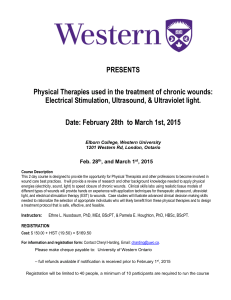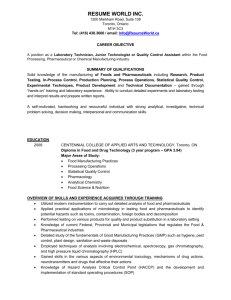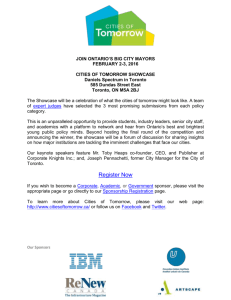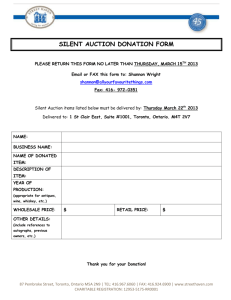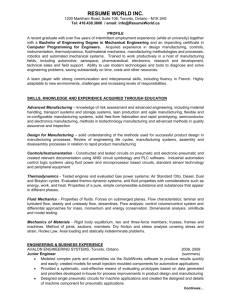Dr. Ethne Nussbaum - Active Potential Rehabilitation Services
advertisement
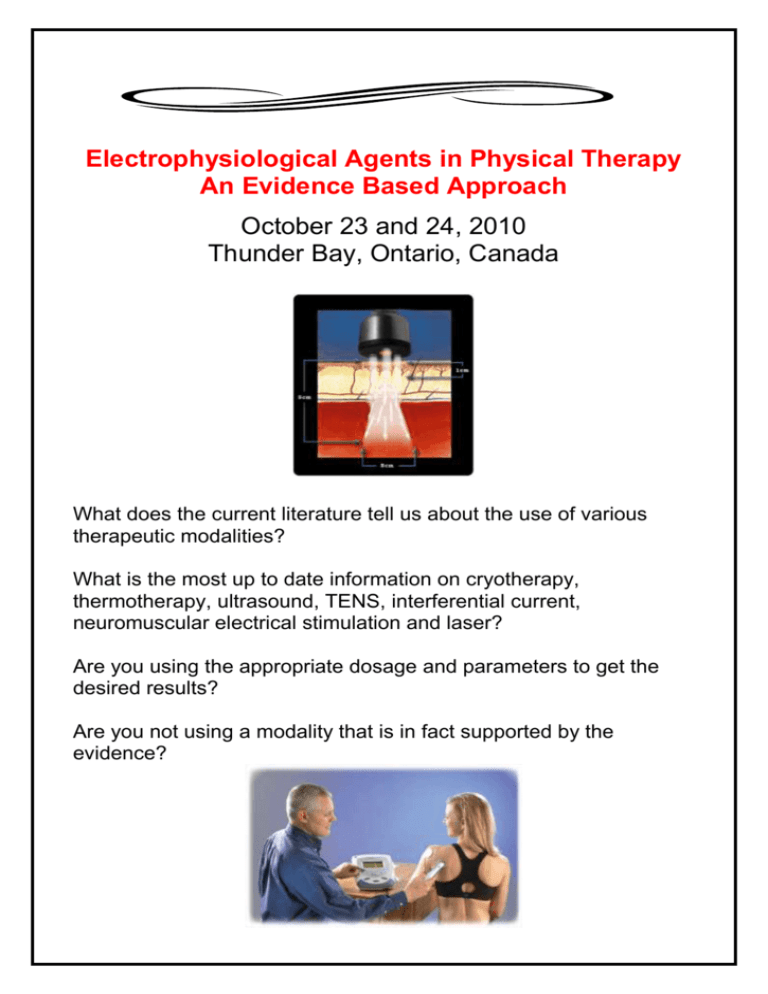
Electrophysiological Agents in Physical Therapy An Evidence Based Approach October 23 and 24, 2010 Thunder Bay, Ontario, Canada What does the current literature tell us about the use of various therapeutic modalities? What is the most up to date information on cryotherapy, thermotherapy, ultrasound, TENS, interferential current, neuromuscular electrical stimulation and laser? Are you using the appropriate dosage and parameters to get the desired results? Are you not using a modality that is in fact supported by the evidence? 2 Dr. Ethne Nussbaum Ethne Nussbaum, Ph.D, M.Ed, BScPT is an Associate Professor in the Department of Physical Therapy at the University of Toronto, Ontario, Canada where she instructs the courses in electrophysical agents. She is also a member of the Graduate Department of Rehabilitation Sciences, University of Toronto, holds a crossappointment to Toronto Rehab in research and is a faculty member within the Masters of Clinical Science degree in the wound healing field at the University of Western Ontario She has a clinical appointment at Mount Sinai Hospital in the Department of Rehabilitation where her focus is on patients with chronic wounds. She is a member of the Board of Directors of the International Society of Electrophysical Agents (ISEPA). The focus of her research is soft tissue repair, in particular on the effects of ultrasound, laser light and ultraviolet radiation and her work is published in numerous peer-reviewed journals. She is a regular guest speaker on the evidence base of electrophysical agents. She has received research funding from the Ontario Neurotrauma Foundation, The Canadian Institutes of Health Research, the Bickell Foundation, the Physiotherapy Foundation of Canada and the Faculty of Medicine, University of Toronto. She has received awards from the University of Toronto for excellence in teaching continuing education, from the Canadian Physiotherapy Association for excellence in research and from Mount Sinai Hospital for staff excellence. 3 Date and Fee: October 23 and 24, 2010 $375.00 per person. Limited enrolment. Deadline: Registration must be received by October 8, 2010 Cancellation: A fee of $75.00 will be charged for a cancellation received before October 15, 2010. After this date, no refund can be made unless a replacement is found. Location: Victoriaville Physiotherapy Centre 611 Victoria Avenue East Thunder Bay, Ontario, Canada P7C 1B1 Contact: Paolo Sanzo 807-623-1322 activepotentialrehab@tbaytel.net Name: _________________________________ Address: _________________________________ Telephone: Home: _________________________________ Work: _________________________________ Fax: _________________________________ Email: _________________________________ Make cheque payable to Active Potential Rehabilitation Services Mail to: Active Potential Rehabilitation Services 3342 Oliver Road Thunder Bay, Ontario, Canada P7G 1S9 4 Topics covered and course breakdown include: Cryotherapy Laser therapy Ultrasound to promote tissue repair Heating tissue Heating continued Electrical current TENS / IFC NMES NMES Demo Wound management Content Beneficial effects of applying cold to prevent development of swelling; possible adverse effects of cold on existing swelling. Effects of cold on sensation, proprioception, tissue stiffness and strength. The importance of timing of cryotherapy in a treatment program. Using ice to reduce pain without adverse effect on tissue healing and extensibility. Questions/discussion Brief review of the main characteristics – wavelength, pulse repetition rate, power density, energy density, coherence. Which characteristics are truly critical to treatment outcome? Efficacy of laser in the treatment of chronic wounds, soft tissue injury, chronic inflammation, fibrosis and pain with clinical guidelines Questions/discussion The evidence for using US to treat ligament, tendon, nerve, and bone injury & for chronic wounds. Effectiveness of ultrasound delivered under water. How long, how often and when to stop. Precautions, contraindications and myths. Questions/discussion Critical temperature for increasing tissue extensibility. Effectiveness of US as a heating agent US vs. SWD vs. hot-pack for heating tissue. The risk attached to using more than one heat treatment. Sequence of a heating agent in a treatment session. US Demo. Introduction to electrical current (all types). Precautions and Safety The critical elements of electrical current in the management of pain – pulse characteristics, amplitude, electrode placement, treatment duration. A new understanding of the mechanism of A-TENS. TENS in long term pain management – looking at a training period and patient education IFC – an unusual waveform but essentially another form of TENS! A clover-leaf pattern – it’s just an IFC myth! Affects of IFC and TENS on circulation, swelling, bone healing and stiffness. Does the evidence support common practice? Questions/discussion Some basics - how many contractions, what rate, what rest period, what muscle length, what electrode size, how often. Russian current – is it another gimmick or a must have modality for strengthening muscle in professional and recreational athletes. Re-education and endurance training in the neurological population. Questions/discussion Re-education of muscle patterning – shoulder complex... Quadriceps strengthening comparing portable & Russian stim. Allowing for demo on a model but longer if participants want to try it out on themselves. I put this in because the new practice authorities for PTs will soon be enacted. The College of PT is at this moment drafting a set of competencies that PTs will need to demonstrate in order to practice in the area of wounds. The course content could cover pathophysiology of wounds (arterial, venous, pressure ulcers), assessment of risk, assessment/measurement of wounds, cleaning/applying dressings to wounds, techniques of treatment using electrical stim & UV radiation. Time 45 min 90 min 60 min 45 min 60 min 60 min 100 min 90 min 45-60 min 120 min A representative from Remington Medical shall provide some units for course participants to utilize during the course as well.
